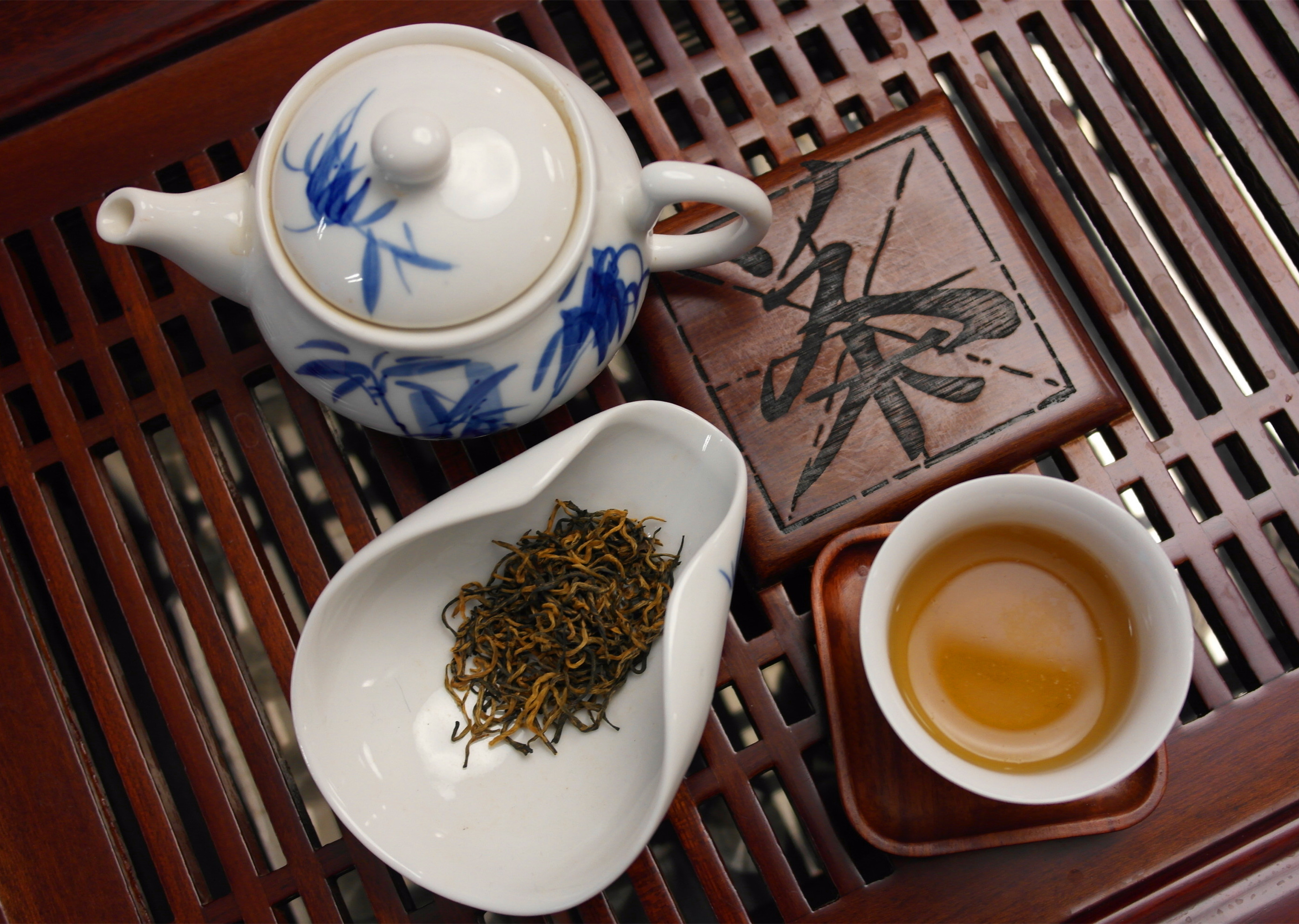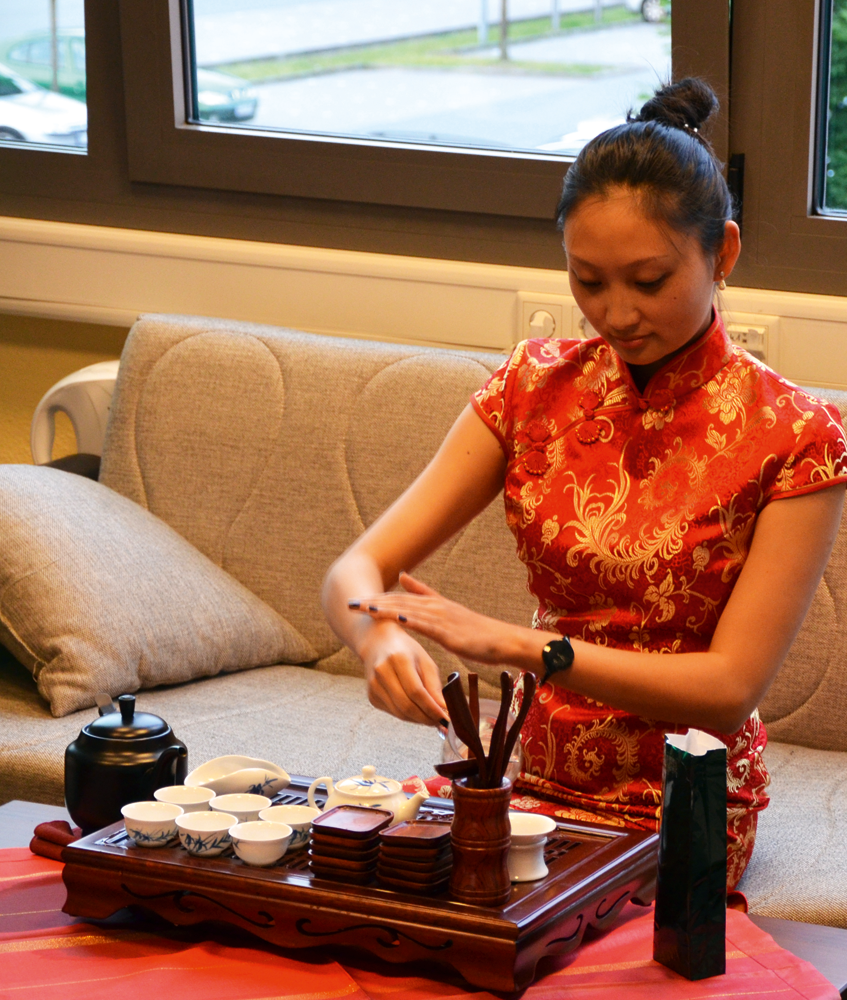The Paragon of Beauty: Chinese Tea Ceremony
CHINESE PEOPlE like drinking tea. What tea is to Chinese people can be compared to what coffee is to Western people. It is considered one of the seven necessities of Chinese daily life, along with firewood (柴 chái), rice (米 mĭ), oil (油 yóu), salt (盐 yán), soy sauce (酱 jiàng) and vinegar (醋 cù). Lin Yutang (林语堂 1895-1976) wrote in his book The Importance of Living (《生活的艺术》 Shēnghuó De Yìshù), “Chinese people drink tea at home, or drink tea at a teahouse; some like to drink alone, some like to drink with others; they drink tea while having meetings, they also drink tea while resolving problems, they drink tea before breakfast, they also drink tea at midnight, as long as Chinese people have a pot of tea, they are happy no matter where they are.” Tea adds more flavour to Chinese daily life.
There are two ways of drinking tea in China: one is ‘mix drinking’ (混饮 hùnyĭn), which involves putting sugar, salt, milk, shallot, orange peel, mint, longan or dates into the tea. Any condiments can be added according to personal taste. The second way of drinking tea is ‘pure drinking’ (清饮 qīngyĭn), which means making tea only from tea leaves and hot water, no added condiments that affect the original flavour of the tea. Pure drinking is divided into four levels. Drinking tea from a bowl to quench your thirst is called ‘drinking tea’ (喝茶 hēchá). If you pay attention to the colour, smell and taste of tea, and you pay attention to the quality of the water and the tea set, slowly savouring the tea is called ‘tea tasting’ (品茶 pĭnchá). If you are particular about the environment, atmosphere, music, brewing technique and interpersonal relationship between the person making the tea and who they are making the tea for, it is called ‘tea art’ (茶艺 cháyì). When the activity of brewing tea is integrated with philosophy, ethics, and morality in cultivating morality and tasting life to achieve the mental enjoyment and purification of the personality, it is called ‘tea ceremony’ (茶道 Chádào) which is the highest state of drinking tea.
Chinese tea ceremony is a real art form. To perform the ceremony, six elements are needed: tea leaves, a tea master, water, tea set, brewing technique and the environment. To achieve the perfect tea ceremony, the six elements have to bring out the best in each other. The beauty of Chinese tea starts with the sensory organ. If you look at the Chinese character of tea (茶 chá) you will notice all the elements of nature that the character is made up of. When the ancient Chinese created this character, they purposely put the character for human (人 rén) between that of grass (草 căo) and of wood (木mù), to convey that humans live amidst nature, absorbing the spirit of nature. The numerous shapes and colours of tea are pleasant to see, and when we appreciate the smell of tea and taste the flavour of tea, we are fully enjoying the gift of nature.
Tea can also be called Ming (茗). Tea leaves picked early in Spring are referred to as tea; tea leaves that are picked later are called Ming. Over the centuries, Chinese people have given many beautiful names to tea, one of the most beautiful names is Jia Ming (佳茗) which means excellent tea. Su Shi (苏轼 1073-1101), a poet from the Song Dynasty (宋朝 960-1279) compared tea to the paragon of beauty in a poem: “A playing little poem is made in order to make you smile, the charm of fine tea is always likened to a great beauty.” (戏作小诗君莫笑,从来佳茗似佳人 Xìzuò xiăoshī jūn mòxiào, cónglái jiāmíng sì jiārén). Tea is delicate, elegant and quiet like beauty.
The tea master, the individual performing the tea ceremony – usually a woman – is the most fundamental and the most beautiful element of the tea ceremony. The beauty of the tea master is the highest form of natural beauty and social beauty. It is also the combination of physical beauty and spiritual beauty. Studying the tea ceremony can make the tea master reach the harmony of expressive beauty, physical beauty and spiritual beauty.
The ancient Chinese used to say “Water is the mother of tea, the tea set is the father of tea” (水为茶之母,器为茶之父 Shuĭ wéi chá zhīmŭ, qì wéi chá zhīfù). It brilliantly portrays that the quality of water has a big influence on the quality of tea. The role of water in making tea can be compared with the role of mother towards her child. The Book of Tea (《茶经》Chájīng) written by Lu Yu (陆羽 733-804) in the Tang Dynasty (唐朝 618-907) has clear regulations on water: “the water from the mountain is best, the water from the river is in the middle, the water from the well
is inferior”. Tea leaves can be described as the spirit of tea, and water as the body of tea. Only when the best water is used to make tea can people enjoy the tea to its fullest.

As ‘the father of tea’, a beautiful tea set has extremely high aesthetic value. Good tea must be prepared using a good tea set, one bringing out the best in the other. The Book of Tea recorded that there were 25 different kinds of tea sets during the Tang Dynasty. Different kinds of tea should be prepared using the corresponding tea sets. Today there are countless precious and beautiful tea sets.
The technique of brewing tea also plays an important role in the tea ceremony. The beauty of the technique is mainly represented in the method and action of brewing tea. Different types of tea should be brewed using different brewing methods. However, the common procedure of brewing tea is: prepare, boil water, prepare tea, warm-up tea wares, add tea, add water, rinse, time, serve tea, taste tea, have an intermission, infuse several times and restore the tea set. The different parts of the method usually have very beautiful names, e.g. the act of adding tea is called ‘Oolong into the palace’ (乌龙入宫 Wūlóng- rùgōng), the act of serving tea is called ‘auspicious dragon bring rain, phoenix nod’ (祥龙行雨,凤凰点头 Xiánglóng-xíngyuˇ, fènghuáng-diăntóu ) which is a metaphor for pouring tea liquor from the serving mug to the teacups fast and evenly, and when there is not much tea liquor in the serving mug, change to the action of nodding slowly with rhythm which also contains the meaning of respecting the guests. Good brewing technique not only fully displays the aroma, colour and taste of the tea leaves, but also brings about aesthetic enjoyment.
The tea ceremony is a poetic art form aiming to purify the soul, so that people’s attention is drawn to the environment in which the tea ceremony occurs. The beauty of an environment is mainly dependant on a quiet and beautiful surrounding, graceful view, warm and sweet interpersonal relationship between the people present at the ceremony and a leisurely mood.
The beauty of the tea ceremony is unique and it is richly influenced by the traditional Chinese culture. From the colourful and diverse tea leaves to the calm, gentle, extraordinary refined tea master; from the clear and fresh water to the precious beautiful tea set; from the natural, elegant brewing tea technique to the peaceful environment – they are all penetrated with the charm of the art. To appreciate the beauty of the Chinese tea ceremony and achieve spiritual sublimation, all sensory organs need to be mobilised.
By Teng Jiaqi (滕嘉琪)

 Share on Facebook
Share on Facebook Share on Twitter
Share on Twitter Share on LinkedIn
Share on LinkedIn